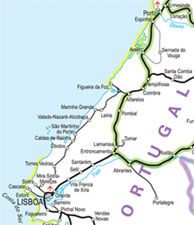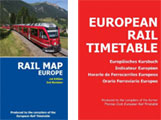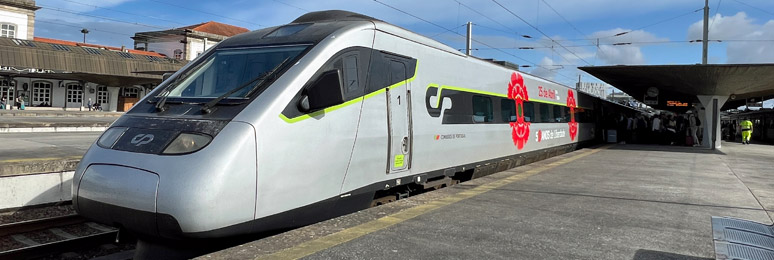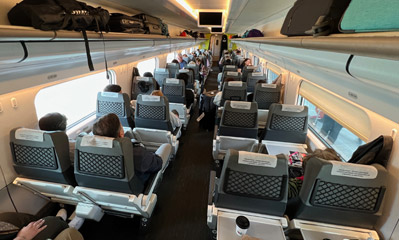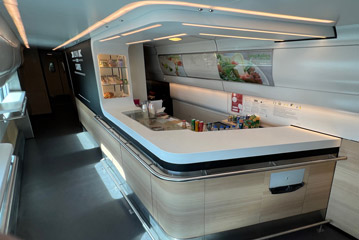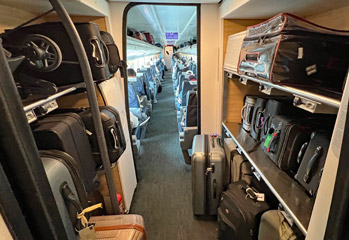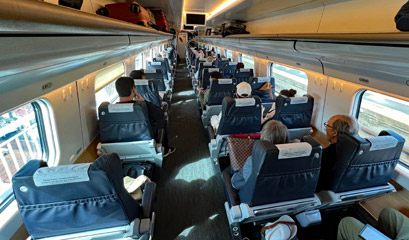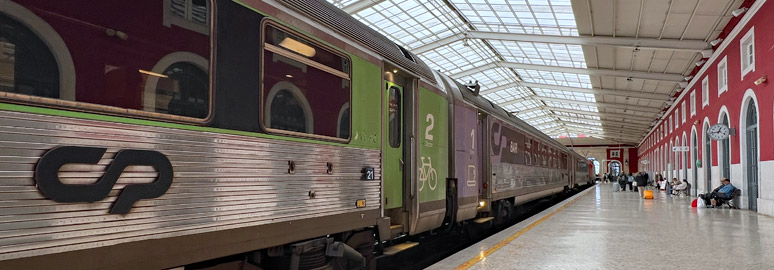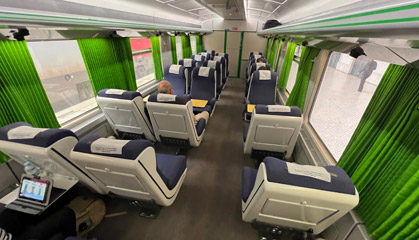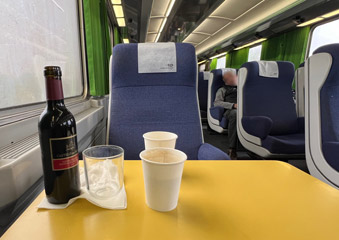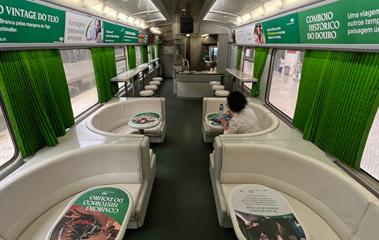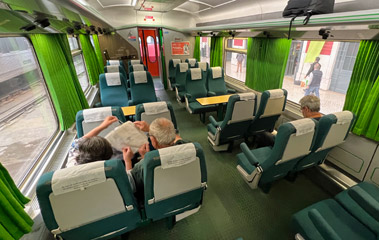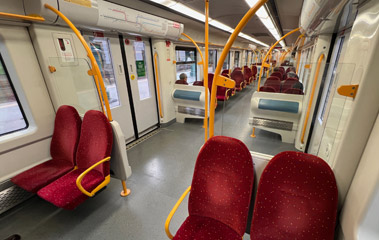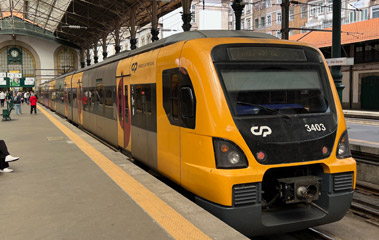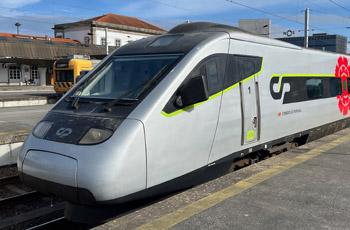 |
|
|
An Alfa Pendular at Porto Campanhã. |
The best way to travel between Lisbon & Porto is by train. Fast trains link Lisbon's Santa Apolonia station with Porto's Campanhã station in as little as 2h58, city centre to city centre. Choose between a tilting 200 km/h Alfa Pendular, or a slightly slower Intercity train.
Lisbon to Porto by train is 337 km (209 miles).
![]() What are Alfa Pendular trains
like?
What are Alfa Pendular trains
like?
![]() What are the Intercity trains
like?
What are the Intercity trains
like?
![]() Transfer to/from Porto São Bento
Transfer to/from Porto São Bento
![]() Station guides:
Lisbon S.
Apolonia, Lisbon
Oriente, Porto Campanhã
Station guides:
Lisbon S.
Apolonia, Lisbon
Oriente, Porto Campanhã
Lisbon ► Porto
-
Trains link Lisbon with Porto every hour or two, some 200 km/h tilting Alfa Pendulars taking 2h58, others older Intercity trains taking 3h23.
Check times at the CP (Portuguese Railways) website www.cp.pt or at Omio.com.
-
In Lisbon, all but two trains leave from the lovely Lisbon Santa Apolonia closest to Lisbon city centre, calling at Lisbon Oriente some 8 km northeast of the city centre 9 minutes afterwards. Lisbon Oriente is located next to the Parque da Nações, the former Expo '98 site. Santa Apolonia is more central and (in my opinion) a much nicer place to board. Two trains a day in each direction link Faro with Porto and these don't serve Santa Apolonia.
-
In Porto, trains arrive at Porto Campanhã, a 35-minute 2.5 km walk from Porto's old town.
However, all Lisbon-Porto tickets allow a free transfer by suburban train from Porto Campanhã to Porto São Bento in the hour after your train arrives. Porto São Bento is in the old town, 8 minutes walk from Porto's iconic iron Dom Luis I bridge over the Douro. Suburban trains run every 5-15 minutes taking 4 minutes. Just look for the next train with destination São Bento.
Porto ► Lisbon
-
Trains link Porto with Lisbon every hour or two, some are 200 km/h Alfa Pendulars taking 2h58, others older Intercity trains taking around 3h23.
Check times at the official CP (Portuguese Railways) website www.cp.pt or at Omio.com.
-
In Porto, trains leave from Porto Campanhã, a 35-minute 2.5 km walk from Porto's old town.
However, all Porto-Lisbon tickets allow a free transfer by suburban train from Porto São Bento to Porto Campanhã in the hour before your train leaves. These suburban trains run every 5-15 minutes taking 4 minutes.
If you use Porto - São Bento as your 'from' station when booking at www.cp.pt it'll show you the suggested transfer time, but this is not a guaranteed connection so I'd take an earlier one giving at least 20 minutes at Campanhã.
The easy way to find a train from São Bento to Campanhã is to use www.cp.pt or the CP app on your phone to look up times. There'll only be one departure from São Bento at that precise time, whatever its final destination.
-
In Lisbon, all trains call at Lisbon Oriente 8 km northeast of the city centre. All but two then continue another 9 minutes to the lovely Lisbon Santa Apolonia walking distance from the city centre. Lisbon Oriente is located next to the Parque da Nações, the former Expo '98 site. Two trains a day in each direction link Porto with Faro and these don't serve Santa Apolonia.
How much does it cost?
-
Promo fares start at just €9.50 in 2nd class or €22.50 in 1st class.
These are advance-purchase tickets which vary like air fares, you must book at least 5 days in advance to see Promo fares, maximum 60 days.
-
Standard price is around €27 by Intercity or €34 by Alfa Pendular in 2nd class, €37 by Intercity or €48 by Alfa Pendular in 1st class.
-
Children under 4 travel free. Children under 12 get 50% off the full-price. There's no discount on Promo fares, which might be cheaper.
-
Youths under 25 get 25% off the full-price. Seniors over 65 get 50% off the full-price. Just show proof of age, for example your passport. There's no discount on Promo fares, which might be cheaper.
How to buy tickets
-
Buy tickets at the Portuguese Railways (CP) website www.cp.pt (in €) or at Omio.com (in €, £ or $).
Booking opens 60 days ahead. You print your own ticket or can show it on your phone, including in the CP app.
Omio.com is easy to use, overseas credit cards welcome, small booking fee. Cp.pt is more fiddly, but has an English version ands works with most overseas payment cards.
Rail Ninja is not an official CP reseller and should be avoided. Omio (who also own Rome2Rio) and CP are the only sites currently authorised to sell Portuguese train tickets, no other retailer connects to CP's system.
-
Booking tips
For Lisbon city centre select Lisboa - Santa Apolonia, or select Lisboa - Oriente for the east of the city & Parque da Nações.
For Porto, you can either select Porto - Campanhã which is the station used by the trains to/from Lisbon, or you can select Lisboa - São Bento and it will show through journeys to/from São Bento closer to the old city, using a suburban train for the free transfer between São Bento & Campanhã.
AP = Alfa Pendular. IC = Intercity. IR = Inter-Regional. R = Regional. U = Urban (suburban train).
AP or IC on their own indicates a direct train. A combo, for example AP|U means Alfa Pendular with 1 change onto a suburban train (it'll show you details if you click the + sign).
When registering on www.cp.pt, it won't accept UK-style postcodes with letters in, so enter your postcode as 123456, it makes no difference.
-
You can buy tickets at the station, there are almost always places available.
Route map
Alfa Pendular (AP) trains
These are CP's premier trains, and very classy indeed. They're fully air-conditioned 6-car electric trains which reach 220 km/h (136 mph) on parts of the Lisbon-Porto route. Built by FIAT, they tilt into the curves, enabling them to go faster than conventional trains. They have 1st & 2nd class and a cafe-bar. There's free WiFi & power sockets at all seats. They are shown in the booking system as AP. See Alfa Pendular seat map.
Alfa Pendular train to Lisbon at Porto Campanhã.
An Alfa Pendular from Porto, arrived at Lisbon Santa Apolonia. The large numbers on the side of each car are car numbers, not class!
Intercity trains
These are CP's second-rank express trains, fully air-conditioned 1st & 2nd class, also with cafe-bar. You'll find power sockets at some 1st class seats, but not in 2nd class. The cars are showing their age now on the outside, but are very comfortable inside. They're shown in the booking system as IC. Typical Intercity train seat map.
Portuguese Intercity train at Lisbon Santa Apolonia.
Transfer to/from Porto São Bento
It's a 35-minute 2.5 km walk from Porto Campanhã to the old town. However, Urbano (suburban) trains link Porto Campanhã with Porto São Bento in the city centre every 5-15 minutes taking 4 minutes. Sit on the left hand side going towards São Bento for your first glimpses of the Douro and Porto's iconic iron bridge. You can look up times at www.cp.pt or the CP app on your phone.
This transfer is free of charge if you have a mainline ticket to/from Porto Campanhã, in the hour after your mainline train arrives or in the hour before it leaves.
Travel tips
-
Alfa Pendular or Intercity? The Alfa Pendular is as good as anything in western Europe, clean, modern, comfortable, with power sockets & WiFi. CP's Intercity trains are showing their age on the outside, they're still very spacious and comfortable on the inside, but the windows are often not as clean as they could be (unlike the immaculate Alfa Pendulars) and not all seats have power outlets. I like both, but it's your call!
-
Seat reservation is compulsory on Alfa Pendular & Intercity trains, all tickets come with a specified reserved seat automatically included. For a seat map of an Alfa Pendular and typical Intercity cars, see the seat maps page.
-
Boarding your train: There's no check-in, you just walk into the station, glance at the departure indicator to see which platform your train is on, walk over to it and get on, any time before departure. Unlike in Spain, in Portugal there are no security scans, no ticket checks & no ticket gates, just free & easy access to the platforms - tickets are checked on board. Train doors may close a minute beforehand.
You'll find the 1st class cars at the Lisbon end of the train on both Alfa Pendular & Intercity trains (at the front going south, back going north).
-
Luggage: You take your luggage onto the train with you and stick it on any suitable rack near your seat or at the end of each car. Suitcases and backpacks are fine, nobody weighs or measures it, if you can manage it yourself and it'll go on a normal train luggage rack, it's fine.
-
Children under 4 go free: Babies and infants under 4 years old travel for free if you're happy to have them on your lap, just bring them along without a ticket. If you want to them to have their own seat, book them a ticket, either child rate or a Promo fare.
-
Children, Youth, Senior fares: Children under 12 get 50% off full-price fares, Youths under 25 get 25% off, Seniors over 65 get 50% off, but there's no discount on Promo fares. When booking, change the Discount box from Full-Price to Children, Youth or Senior after you've selected your train. Important tip, check that selecting Full-Price and Promo Ticket (in other words, buying an adult-rate Promo fare) doesn't make it cheaper! If it is, buy that.
-
Food & drink: Alfa Pendulars have a cafe-bar in car 3. Most Intercity trains on the Lisbon-Porto route also have a cafe-bar. You can buy beer, wine, tea, coffee, soft drinks, sandwiches and snacks, with a menu in both Portuguese & English. They even sell small bottles of delicious port (well, this is Portugal!).
-
WiFi & power outlets: Alfa Pendulars have free WiFi & power sockets at all seats in both 1st & 2nd class.
Intercity trains may or may not have WiFi, and only a few seats have power sockets, mainly in 1st class. Seats with a socket are indicated with a plug symbol in the seating plan when you book an intercity train at www.cp.pt.
-
First class lounge at Lisbon Oriente (temporarily closed): If you have a 1st class ticket for an Alfa Pendular, you can use the 1st class CP Lounge at Lisbon Oriente with free WiFi & complimentary tea & coffee. It's badly signed, but is reportedly on the mezzanine level. However, it's been closed since the pandemic, it may reopen at some point.
-
Interrail & Eurail passes: These trains are all covered by Interrail & Eurail, but you'll need a compulsory seat reservation which costs a few euros. Make this at any CP station, it cannot be done online, and cannot be done at any station outside Portugal as no other operator or retailer has a connection to CP's ticketing system.
Above: Crossing the Douro. As the train from Lisbon approaches Porto Campanhã, it crosses the Douro on the modern concrete Ponte de São João, with Gustave Eiffel's original wrought iron Ponte de Dona Maria Pia of 1877 visible on the left. The double-track Ponte de São João replaced Eiffel's single-track bridge in 1991.


